 DOG DANGER!
DOG DANGER!
The best treatment is prevention, avoid activity in high temperatures! We will discuss more about prevention in the next blog, however, that said, it is still very important to know the signs and symptoms of heat exhaustion.
- Excessive/rapid panting/difficulty breathing. As dogs heat up, panting with a slightly open mouth with turn into a fully openmouthed pant plus a swollen tongue that hangs out to the side. This means shade and rest immediately!
- Dehydration – signs may include sunken eyes, dry nose, visible tiredness…. in people, something we look at is the skin. If you pinch an area of skin, it should pop back into place as soon as you release it. Dogs too!
- Excessive drooling – if your dog is drooling A LOT, it may be a sign they are having a hard time cooling down.
- Tired/weak- you may find in the heat, your dog wants to lay down more often which is a clear sign they need to take a break and cool off. If you dog is having trouble standing up or collapses in the heat, take them to your emergency vet immediately.
- Muscle tremors – uncontrolled shaking after being in warmer temperatures can very likely be a sign of heat exhaustion.
- Fast/Irregular pulse – place your hand on the front of their chest, near their elbow. If its racing or really irregular, its a medical emergency – go to the vet ASAP!
- Vomiting/diarrhea. – If your dog has been in the heat and is experiencing lack of appetite, vomiting, or diarrhea, this is a big warning of heat exhaustion and again a medical emergency – go to the vet ASAP!
- Neurologic signs – Any unusual changes in behaviour, difficulty walking, stumbling, etc is again a very strong warning of heat exhaustion and possibly heat stroke and requires urgent veterinary attention. Go!
If you muzzle your dog or walk them with a any device that inhibits their ability to open their mouth wide enough to pant, your dog may overheat faster and be at higher risk of heat exhaustion
What makes some dogs more at risk to heat stroke?
Differences in the respiratory system can cause a dog to be more susceptible to heatstroke. Flat faced (brachycephalic) dogs pose a higher risk of heat stroke.

Dog in colorful sunglasses having fun at turquoise beach in Northern Norway
Breeds like Pugs, Bulldogs, French Bulldogs and Boxers are at higher risk due to differences in their airways.
Another condition that affects the airways is laryngeal paralysis, common in some medium and larger breeds such as pitfalls and labradors.





